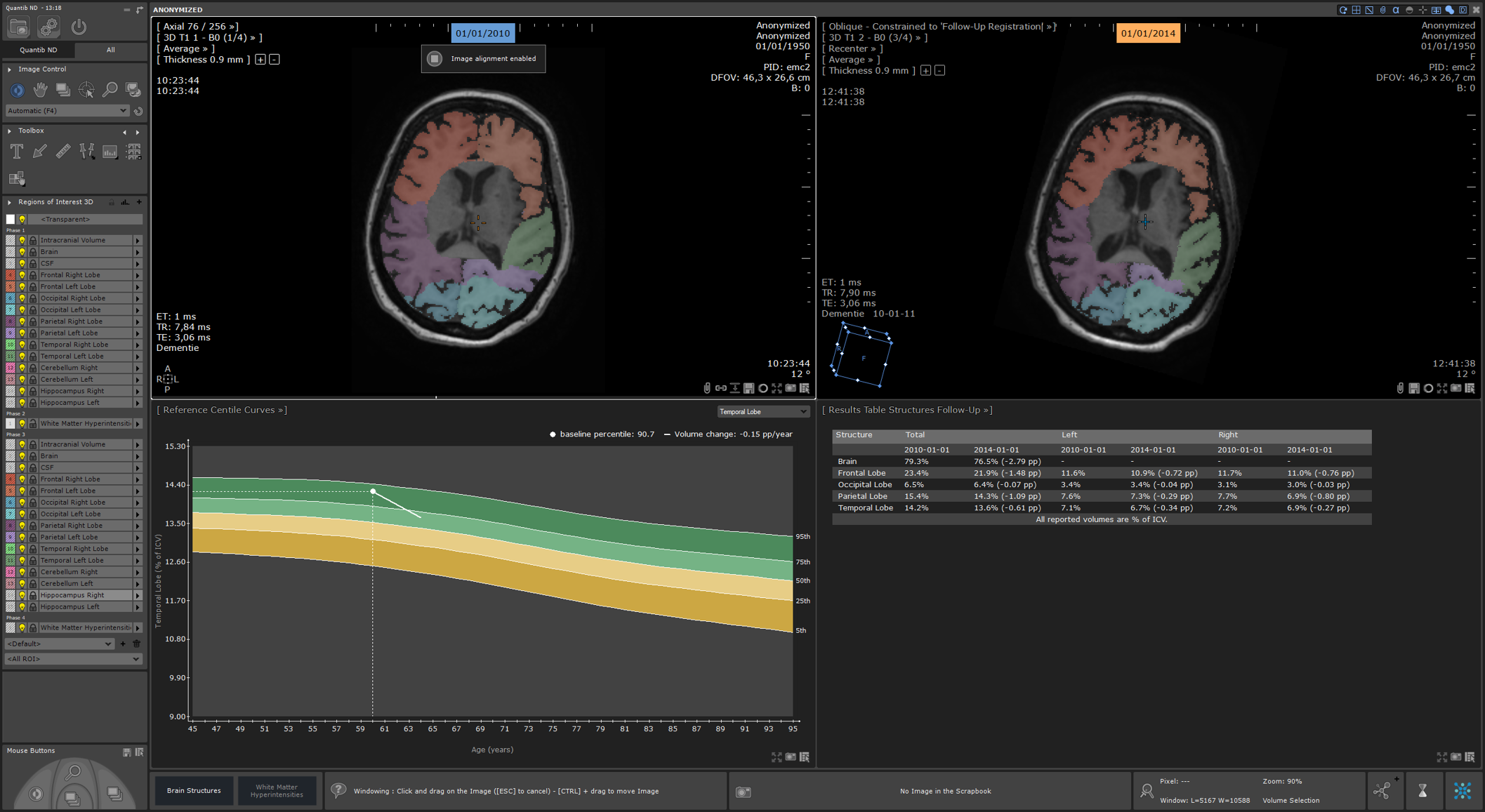Quantib, the market leader in artificial intelligence tools for radiology, released a major upgrade of their dementia and MS detection support software Quantib® ND Plus. A substantial list of new features supporting the detection and monitoring of dementia and multiple sclerosis was added to previous software functionalities resulting in a unique radiology software product.
“The possibilities of Quantib® ND Plus have extended considerably with this new release,” says Arthur Post Uiterweer, CEO of Quantib. “We are very proud to offer physicians an extensive software package for quantitative measurements of dementia and MS-related neurological changes. Last week, we had already installed the new tools at key sites in Europe and are thrilled with the encouraging responses. Over the next few weeks, many more installations will follow and we are keen to get more feedback.”
Next to offering accurate quantification of brain atrophy and white matter hyperintensities, as well as changes in the brain related to dementia and MS, the software proves to be a robust tool for objective disease development tracking. The product includes graphs providing information on the expected brain volume at a certain age. Physicians can leverage this information to compare the brain volume of their patient to that of a representative cross-section of the population, i.e. determine the difference between expected and measured brain volume.
Rudolf Scholte, COO of the company, emphasizes the significance of the release. He stated, “You should actually think of this product as two combined in one. The software includes an exhaustive atrophy measurement tool and a white matter hyperintensity tracking tool. These two neurological biomarkers are relevant for both MS and dementia; therefore, we decided to bundle the tools into one product.”
An advantage of the Quantib solution is the option to keep all scans within the hospital and process them locally; there is no need to upload patient scans to an external server. Quantib® ND Plus is installed on the premises of the institute; hence, patient scans are processed behind the hospital firewall, offering the most secure option to protect patient data. Additionally, the Quantib solution allows the user full access to the segmentations and not just a PDF report. The physician has complete control.
Quantib® ND Plus is CE marked and available throughout Europe for specialists to accelerate and refine their diagnosis process. The software may be integrated into the current (PACS) workflow of radiology departments, making the results accessible directly from the PACS worklist. Alternatively, it may be installed as a dedicated post-processing workstation for the heavy users.

About Neurodegenerative Disorders
In the upcoming decennia, neurodegenerative diseases will have an enormous impact on society. The Alzheimer’s Association estimated in their 2015 World Alzheimer Report that the world will count ~100M people with Alzheimer’s in 2014.1 Last month, Bill Gates announced that he will invest $30M in the improvement of diagnosis of Alzheimer’s disease to support cutting back the rates of neurodegenerative diseases.2
Although some risks on dementia are genetically determined, a recent publication in the Lancet shows that 35% of risk factors are modifiable. Therefore, early discovery of dementia or of mild cognitive impairment (often a pre-stage of dementia) is of great importance. Additionally, this paper demonstrates clearly how clinical research in the field of dementia is progressing rapidly. Quantib® ND Plus is eminently suitable in the acceleration of this research even further and improves accuracy by quantifying results.3
About Quantib
Quantib strives for faster and more accurate diagnoses, supporting adequate and timely patient care. Using advanced machine learning techniques, Quantib’s products can detect changes in tissue sooner than would be possible with the naked eye. Quantib has multiple machine-learning products cleared by FDA and/or CE marked. These products are focused on the detection of dementia and MS. Simultaneously, the company is collaborating with, among others, Erasmus MC Rotterdam, for the development of applications in the oncology and MSK space.
Curious to learn more about Quantib™ ND? Visit the Quantib™ ND webpage.
- Prince, Martin; Wimo, Anders; Guerchet, Maëlenn; Ali, Gema-Claire; Wu, Yu-Tzu; Prina, M. World Alzheimer Report 2015: The Global Impact of Dementia. Alzheimer’s Dis. Int. 1–88 (2015). doi:10.1111/j.0963-7214.2004.00293.x
- Gates, B. Gatesnotes. Why diagnosing Alzheimer’s today is so difficult—and how we can do better (2018). Available at: https://www.gatesnotes.com/Health/A-better-way-of-diagnosing-Alzheimers?WT.mc_id=20180717193325_AlzheimersBiomarkers_BG-LI&WT.tsrc=BGLI&linkId=54393851.
- Livingston, G. et al. Dementia prevention, intervention, and care. Lancet 390, 2673–2734 (2017).